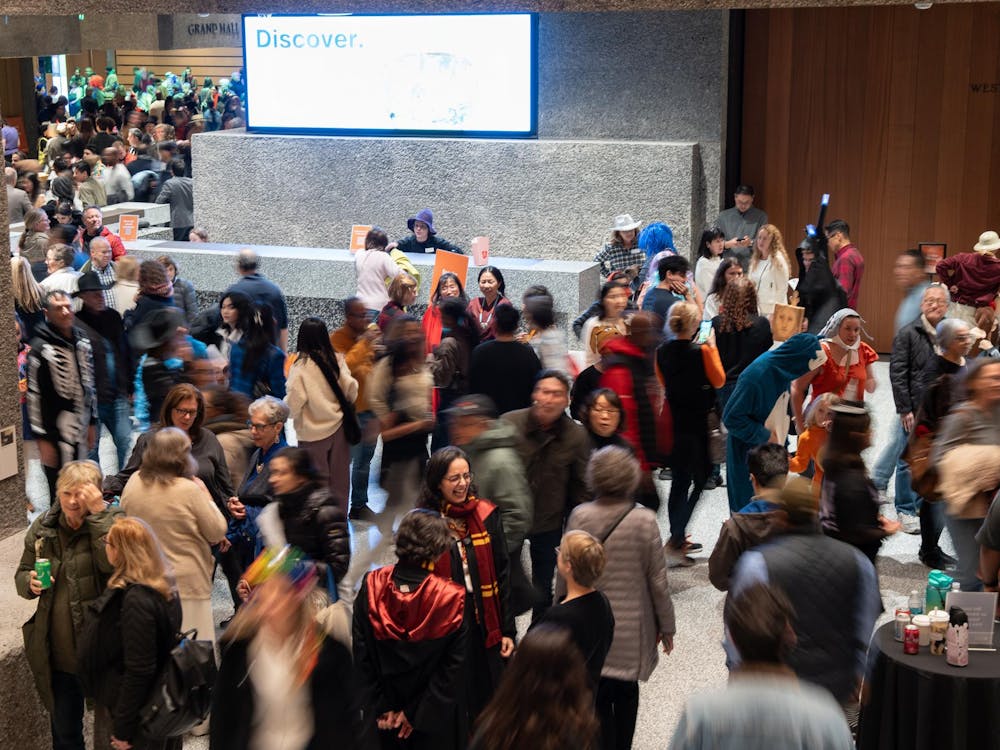In the Princeton University Art Museum’s Ancient Mediterranean pavilion, each step carries you across centuries and civilizations.
Entering the pavilion, you tread upon a glass floor, beneath which lies a mosaic pavement once used as flooring in an elite villa in the ancient city of Antioch, now modern-day Turkey. You then pass a mixing bowl from the 4th century B.C.E. in southern Italy, featuring rich shades of black, orange, and white, which create stark contrasts and dazzling designs. Across from this, you see another vessel with art of a similar style; yet, rather than depicting a Greek god or a Roman emperor, it depicts modern city streets, telephone poles, and graffiti. This is the work of Roberto Lugo, a modern ceramicist who takes inspiration from ancient Greek art for his modern day works.

Mosaic pavement depicting Apollo and Daphne from the late 3rd century CE.
Zane Mills Vanwicklen / The Daily Princetonian
In an interview with The Daily Princetonian, Associate Curator of Ancient Mediterranean Art Carolyn Laferrière calls this contrast another one of the “surprising juxtapositions” the pavilion presents to museum visitors. Through this decision, she hopes to inspire “curiosity,” inviting people to ask “questions or … rethink assumptions.”
Laferrière also says that, in the Ancient Mediterranean, art was used to tell stories. In Lugo’s vase, one continues to see how “art is a really powerful vehicle for telling the stories of your community and of people who did extraordinary things.” Visitors are asked not to simply glance at a wall of ceramics but rather delve into the details of each piece, to ask how the works were made in the ancient world and how they are made today.
Echoing this point, art and archeology professor John Sigmier says these surprising juxtapositions “make the past seem not so alien.” While the objects in the pavilion may appear “strange” at first, their pairing with a contemporary piece of a similar visual idiom allows visitors to view depictions of life in the ancient world as they would those of life in the 21st century.
The pavilion puts pieces that span great gaps in time and space in conversation with one another, seeking to accomplish the museum’s goal of promoting “dialogue among diverse audiences, foster[ing] inquiry and curiosity, and afford[ing] encounters that excite the imagination,” as stated in its mission statement. Sigmier said that the space achieves this goal and that he plans to bring the students in his courses to the pavilion and say to them, “Here’s what we’re talking about.”

Case of ancient ceramics, including vases, bowls, and cups.
Zane Mills Vanwicklen / The Daily Princetonian
The pavilion situates itself within a larger global community. Laferrière chose pieces from the ancient civilizations of “Near East, Egypt, Greece, Italy, and the Roman and Byzantine Empires,” to reveal that objects, people, and ideas moved across the Ancient Mediterranean; each piece is placed in conversation with one another. A visitor walking past various sculptures of Aphrodite from different time periods and places experiences the similarities between the pieces and the inspirations the ancient peoples took from one another.
One fascinating element of the pavilion is that these pieces not only tell ancient stories but also give insight into modern geopolitical relationships. For example, former art and archeology professor Ernest DeWald Class of 1916 GS discovered that a marble head of a goat on display in the old art museum had been stolen from the Capitoline Museums in Rome during World War II. After learning this, the museum returned the piece to its rightful owners in 1953. According to Lafèrriere, Italy was so grateful for the gesture and, knowing it to be a favorite of the students, returned it to Princeton. Beside the piece is a photo of the ceremony in which it was bestowed upon the University.
These works thus span great gaps both in time and space. The visitor, in perusing the pieces, travels these distances with single steps, one moment examining a vase from fourth century B.C.E. Greece and another a fragmented statue from second century C.E. Rome. In organizing the pieces, Laferrière aimed to highlight the “range of lived experience that was available in the ancient world.”

Case of ancient artwork depicting animals.
Zane Mills Vanwicklen / The Daily Princetonian

Each of the works holds a story. Whether in “surprising juxtapositions” or clear pairings, the artwork whispers tales of war, love, ritual, and everyday life to its visitors.
The pavilion presents these works in all their uniqueness and splendor, telling a story not just of the diversity of these civilizations and the connections to modernity but of a world in which we are all connected, where we are inspired by one another to bring forth newness and originality.
Laferrière wants visitors to leave with a sense of “curiosity” and “to think through some of the questions that the ancient objects are asking of themselves,” for many of them we continue to ponder today.
Zane Mills VanWicklen is a contributing writer for The Prospect and a member of the Class of 2029. He can be reached at zm6261@princeton.edu.
Please send any corrections to corrections[at]dailyprincetonian.com.








